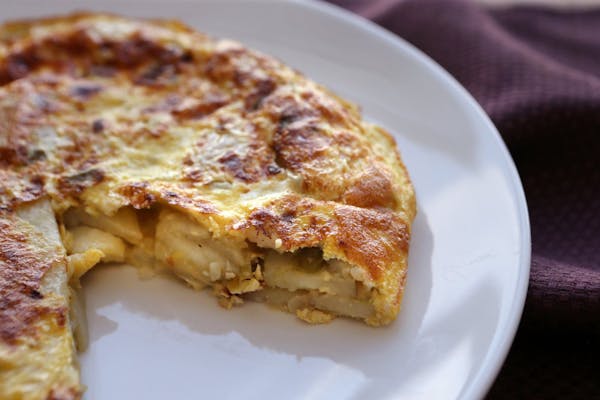Feeding your family a good meal is easy. Just go to the grocery store and empty out your pocketbook.
But what if you aren't so flush? What if your wallet is looking a little lean? What if times are hard and money is short?
Everybody has to eat, right? And it is better to eat good food than bad.
So I decided to cook some delicious and even elegant meals to feed a family of four for less than $7. It is not difficult to do; all it takes is a bit of imagination.
Imagination, and an inexpensive protein — no steak or lobster for these meals. Even ground beef and chicken have become so expensive that they can no longer be relied upon for a cheap meal. If you are looking to stretch your budget, you'll need to stick with the essentials: beans, eggs and pasta.
First, the ground rules. I bought my food at a discount store. In determining the price of each meal, I took into account only the cost of the amount of the food that I used and put the rest aside for future use.
My 25.4-ounce bottle of olive oil cost $5.99, so two tablespoons of oil was about 23 cents. One tablespoon of butter, at $3.50 a pound, cost 11 cents. A dozen large eggs cost me $2.09, so six of them were $1.05.
In addition, I also kept to items that most or many people would ordinarily have in their pantry. No weird spices, no truffle-infused honey. I did buy some items on sale, but only if I needed them for my recipes — I did not alter the recipes to use sale items.
All of the dishes were surprisingly good, but the one that surprised me the most was one I created myself. I call it Sausage, Beans and Polenta, and it was inspired by one of my favorite dishes at one of my favorite restaurants. It takes a bit of work to make, but that is why it tastes so good. First, you have to soak the beans overnight and then make the polenta — if you make it right, almost as you would a risotto, it is impossibly smooth and creamy. It is so creamy that you'll think there is cream in it, or at least cheese. Nope. Just corn meal, water and salt, and a quick smear of butter when it is done. Then you have to chill the polenta for at least two hours to get it stiff enough to fry.
Trust me on this: You'll want to pan-fry the polenta. Don't bother with oil, it only needs a bit of butter.
Then you make a nice, garlicky sauce for the beans, add the sausage and spinach, and serve it with a wedge or two of polenta. It is sheer, hearty bliss, and only costs $5.72 for four servings.
For a more traditionally elegant meal, I slightly adapted a version of Marcella Hazan's justifiably famous recipe for Spaghetti With White Clam Sauce. I made mine with linguine. I also had to cut back on the amount of clams, because clams aren't cheap, and I substituted an onion for shallots, for the same reason. Still, the classic Italian dish had a marvelous flavor.
Part of the reason for the meal's success is the judicious use of dry white wine. Of course, good wine will cost more than our budget could handle, and bad wine will ruin a dish. The standard culinary dictum is to cook only with wine you would drink, but in this case you should use the cheapest wine you can stand. In this case, a bottle of Yellowtail chardonnay for $4.99 did the trick nicely.
Even with the clams and the wine, the tab came in at $6.23 for a family of four.
Somewhat cheaper, and just as delicious, is a bean stew that you make in the slow cooker. This is a vegetarian option (unless you use chicken stock, as I did), and it is ridiculously easy to make. Just throw all the ingredients into a slow cooker, set it on low, and come back to eat it six hours — or more — later. And because it is a slow cooker, you don't even have to soak the beans first.
It is remarkably good, and it is also quite good for you. And all of this will only set you back $5.11 for six servings.
And naturally I had to make an egg dish. Eggs are cheap. Eggs are good. Eggs are full of protein. And, it should be repeated, eggs are good.
I made a Spanish omelet, which is said to be one of the most popular dishes in Spain. It's certainly filling and addictive. But despite its name, it isn't really an omelet at all; it is more accurately a frittata, in which the egg and vegetables are mixed together and are flipped once in the pan, rather than folded over.
Spanish omelets always use sliced potatoes and onions, and I added a green pepper to mine for extra flavor and because I felt like splurging. I heated this combination until it was cooked through — because of the potatoes, this took several minutes — added it to my beaten eggs and then poured it into a pan coated with hot oil. The oil is necessary to create the distinctive brown color of a Spanish omelet. I flipped it once, using a plate on top of the pan, cooked it for a couple of minutes more, and then served it.
Wow, that was good. So good, it is hard to believe you could feed a family of four with one for just $4.27.
